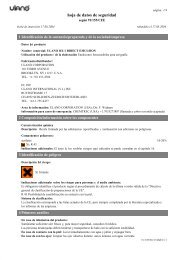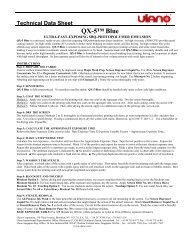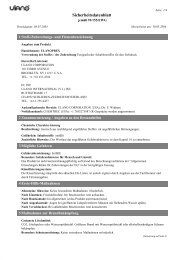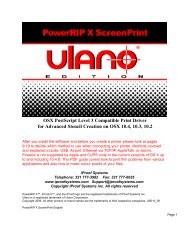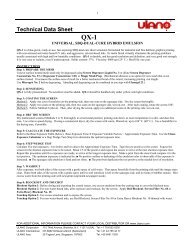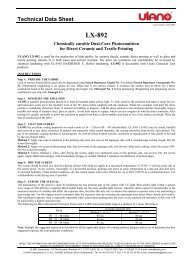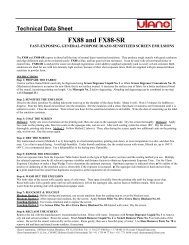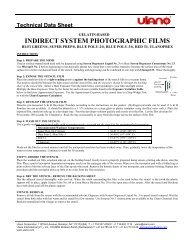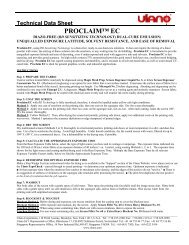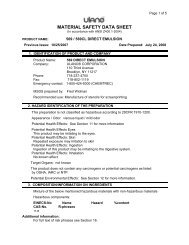Create successful ePaper yourself
Turn your PDF publications into a flip-book with our unique Google optimized e-Paper software.
<strong>Tech</strong>nical <strong>Data</strong> <strong>Sheet</strong><br />
LX-660-<strong>Blue</strong> (New and Improved)<br />
DIAZO-PHOTOPOLYMER (DUAL-CURE) DIRECT EMULSION WITH SUPERIOR<br />
RESISTANCE TO WATER-BASED INK SYSTEMS<br />
LX-660-<strong>Blue</strong> is a durable, diazo-photoplymer (dual-cure) emulsion with superior resistance to water-based ink systems, as well as many<br />
solvent- based inks. It is suitable for virtually all general purpose graphics and industrial applications. LX-660 blue is supplied with premeasured,<br />
powder diazo sensitizer.<br />
INSTRUCTIONS:<br />
Step 1: PREPARE THE FABRIC<br />
Used or surface treated fabric need only be degreased using Screen Degreaser Liquid No. 3 or dilute Screen Degreaser Concentrate No. 33.<br />
(Mechanical roughening is an option for new fabric that is not surface treated. It increases the surface area of fabric for a better mechanical<br />
bond of the stencil, increasing printing run length. Use Microgrit No. 2 before degreasing. Roughening and degreasing can be combined in one<br />
step with Ulanogel 23.)<br />
Step 2: SENSITIZE THE EMULSION<br />
To sensitize LX-660-<strong>Blue</strong>, add water up to the shoulder of the diazo bottle supplied with the emulsion. Shake the container well<br />
until the diazo powder is completely dissolved. Add the diazo solution to the emulsion and mix thoroughly using a suitable tool<br />
made of stainless steel, glass, or plastic until the emulsion is uniform in color. Close the container. Wait at least one hour for the<br />
emulsion to debubble. Write the date of sensitizing on the label..<br />
Step 3: COAT THE SCREEN<br />
Method 1: Apply one coat of emulsion to the printing side, then one coat on the squeegee side. Dry the screen thoroughly.<br />
Method 2: Apply two coats on the printing side, then two coats on the squeegee side, wet-on-wet. After each coating, rotate the screen 180º.<br />
Dry the screen thoroughly/<br />
Method 3: Follow Method 2. Then, after drying the screen, apply two additional coats on the printing side, wet-on-wet. Dry the screen again.<br />
Method 3 optimizes the definition of printed edges.<br />
Step 4: DRY THE SCREEN<br />
Dry multicoated screens (Methods 2 or 3) thoroughly in a horizontal position, printing side down, at room temperature in a dirtand<br />
dust-free area. Use a fan to accelerate the drying. Ideally, dry the coated screen in a commercial drying unit, with warm,<br />
filtered air, up to 104º F (40º C). Use a dehumidifier in the drying area, if possible.<br />
Step 5: CALCULATE THE APPROXIMATE EXPOSURE TIME:<br />
From the Base Exposure Table below, select the type of light source you have and its wattage or amperage. The exposure times<br />
indicated are for 305/inch (120/cm.) white fabric at an exposure distance of 40 inches (=ca. 1 meter), using coating Methods 1, 2,<br />
or 3. The exposure time shown for your light source and coating method is your Base Exposure Time. Multiply your Base<br />
Exposure Time by all relevant Exposure Variable Factors (table, below) to find your Approximate Exposure Time.<br />
Step 6: DETERMINE THE OPTIMAL EXPOSURE TIME<br />
Make a Step Wedge Test (instructions can be found in the Ulano Direct Emulsions <strong>Tech</strong>nical <strong>Data</strong> Booklet) or use the Ulano Exposure<br />
Calculator Kit—carried through to actual printing—to determine your optimum exposure time. Optimum exposure is indicated: ■ At that<br />
exposure time when the emulsion first reaches its maximum color density and the edges of the positive do not "resolve." ■ The squeegee side<br />
emulsion is hard, not soft or slimy. ■ The print best duplicates the test positive at the level of resolution that the job requires.<br />
Step 7: WASHOUT<br />
Wet both sides of the screen with a gentle spray of cold water. Then spray the printing side forcefully until the image areas clear. Rinse both<br />
sides with a gentle spray until no soft emulsion is left on the squeegee side, and no foam or bubbles remain. Blot excess water from the printing<br />
side with newsprint (unprinted newspaper stock).<br />
Step 8: BLOCKOUT AND TOUCHUP<br />
Blockout Option 1: Before drying and exposure, use excess emulsion from the coating step to cover the blockout area.<br />
Blockout Option 2: When using non-water-based inks, dry the screen after exposure and washout. Apply Screen Filler No. 60 or Extra<br />
Heavy Blockout No. 10.<br />
Ulano Corporation, 110Third Avenue, Brooklyn, NY 11217(USA). Tel: +1 718 237 4700 Fax: +1 718 802 1119 e-mail: Ulano@Ulano.com<br />
Ulano International (V.I.), Inc., CH-8952 Shlieren-Zurich (Switzerland) Tel: +41 1 755 44 77 Fax + 41 1 773 16 06 e-mail: ulanoeurope@Ulano.com
<strong>Tech</strong>nical <strong>Data</strong> <strong>Sheet</strong><br />
Step 9: RECLAIM THE SCREEN<br />
Remove ink with the appropriate solvent. Rinse the screen with water. Degrease the screen with Screen Degreaser Liquid<br />
No. 3 to remove ink residues. Rinse with a forceful spray. Brush Stencil Remover Liquid No. 4 or Stencil Remover Paste<br />
No. 5 on both sides of the screen. Do not let the stencil remover dry on the screen. Wash with a forceful spray of water. Use<br />
Haze Remover Paste No. 78 or Ghost Remover and Ghost Remover Activator to remove ink and haze residues.<br />
BASE EXPOSURE TABLE (for 304/inch (120/cm) white polyester or nylon at 40 inches (100cm) exposure distance).<br />
Carbon Arc Coating Method 1 Coating Method 2 Coating Method 3<br />
15 amps 280 sec. 14 min. 18 ½ min.<br />
30 amps 140 sec. 7 min. 9 ½ min.<br />
40 amps 105 sec. 315 sec. 7 min.<br />
60 amps 70 sec. 210 sec. 280 sec.<br />
110 amps 38 sec. 115 sec. 150 sec.<br />
Metal Halide<br />
1000 watts 60 sec. 175 sec. 230 sec.<br />
2000 watts 30 sec. 90 sec. 115 sec.<br />
3000 watts 20 sec. 60 sec. 75 sec.<br />
4000 watts 15 sec. 46 sec. 58 sec.<br />
5000 watts 12 sec. 35 sec. 46 sec.<br />
Pulsed Xenon<br />
2000 watts 164 sec. 8 ¼ min. 11 min.<br />
5000 watts 66 sec. 196 sec. 4.5 min.<br />
8000 watts 41 sec. 123 sec 165 sec.<br />
Mercury Vapor<br />
250 watts 10.5 min. 16 min. Not recommended<br />
2000 watts 40 sec. 120 sec. 160 sec.<br />
4000 watts 20 sec. 60 sec. 80 sec.<br />
Fluorescent Tubes*<br />
FT 40 watts 3.5 min. 8.8 min. Not recommended<br />
*Base exposure times are for unfiltered black light, or super diazo blue tubes, at 4-6’ (10-15 cm) exposure distance. For plant-light, filtered<br />
black light, and “daylight” tubes, use double the time at least.<br />
EXPOSURE VARIABLE FACTORS (Factors for Variables Affecting Base Time)<br />
Fabric:<br />
Viscosity Adjustment:<br />
Steel/metalized polyester 2.0 – 4.0 5% dilution 0.95<br />
Dyed Fabric 1.5 – 2.0 10% dilution 0.9<br />
305T white polyester or nylon 1.0 5% more viscous 1.1<br />
Finer than 330T (130T/cm) 0.7 - 0.9<br />
Coarser than 250T (100T/cm) 1.1 - 2.0 High Heat and Humidity:<br />
Multifilament PET 1.3 – 1.5 Factor 1.3 – 1.8<br />
Exposure Distance:<br />
20”/50cm 0.25 40"/100cm 1.00 Taped-up Positives:<br />
24”/60cm 0.36 52"/130cm 1.69 Factor 1.2 – 1.3<br />
28”/70cm 0.49 60"/150cm 2.25<br />
32”/80cm 0.64 72"/180cm 3.24 Vellum Positives:<br />
36"/90cm 0.81 100"/250cm 6.25 Factor 1.3 – 1.5<br />
HANDLING: LX-660 is partially presensitized and should be handled under yellow safelight conditions before exposure.<br />
STORAGE: Unsensitized emulsion (with no diazo added) can be stored for up to 1 year. Sensitized emulsion can be stored for 3 - 6 weeks at<br />
room temperature, and up to 3 months in a refrigerator. Store coated screens in cold, dry, completely dark area until exposure.<br />
1003dm<br />
Ulano Corporation, 110Third Avenue, Brooklyn, NY 11217(USA). Tel: +1 718 237 4700 Fax: +1 718 802 1119 e-mail: Ulano@Ulano.com<br />
Ulano International (V.I.), Inc., CH-8952 Shlieren-Zurich (Switzerland) Tel: +41 1 755 44 77 Fax + 41 1 773 16 06 e-mail: ulanoeurope@Ulano.com



